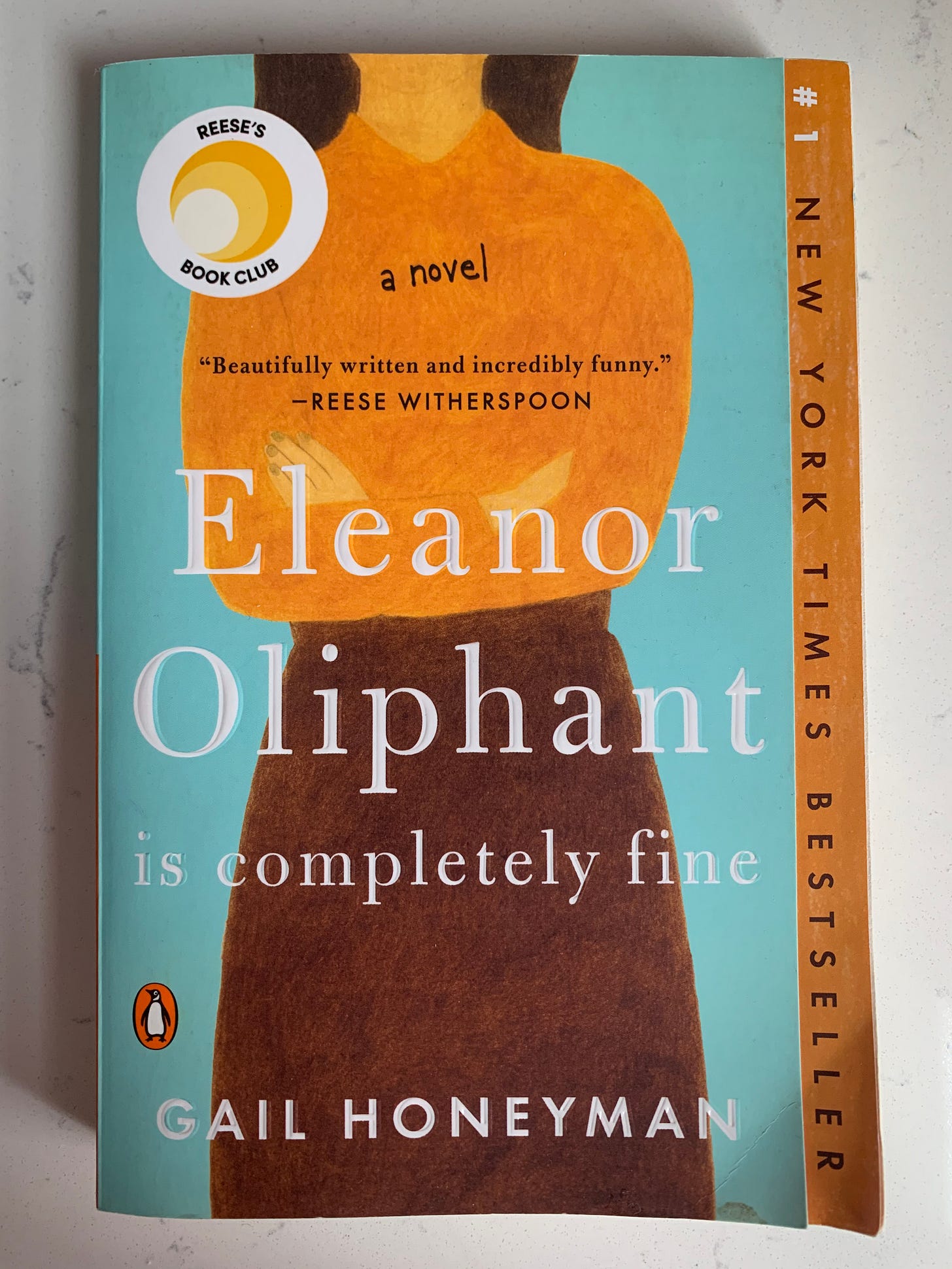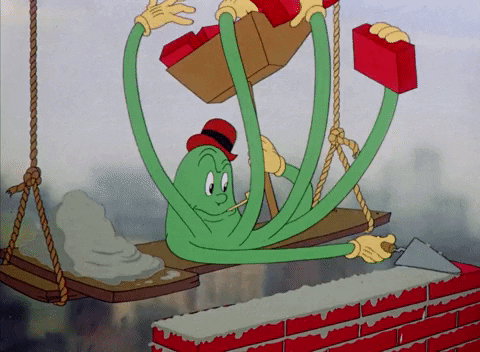'Eleanor Oliphant Is Completely Fine' by Gail Honeyman
'Thank you for making me shiny.' — Review #149
Welcome to Books on GIF’s final edition of 2020. It’s been a crazy year, and I don’t know about you, but I’m tired. So I’m going to take a short break to recharge and get caught up on some reading. Look for BoG to return to your inboxes on Jan. 3. But first, I’m excited to close this hellish year with a great book recommendation from one of you. Here’s the cover:
If you enjoy this review, click the ♥️ above. New here?
‘Eleanor Oliphant Is Completely Fine’ was recommended to me by my good friend Leela over a year ago. A group of us went to see ‘Once Upon a Time in Hollywood’ at the Nighthawk in Park Slope where she wrote down the book’s title on one of those slips you use to order food and drinks. (I miss going to the Nighthawk and enjoying the tater tots!) I put the folded paper into my jacket pocket and forgot about it until it turned up again recently. I acquired a copy at the Strand, and here we are. When we meet Eleanor, a 30-year-old working in the accounting department of a Glasgow graphic design company, we see she is not completely fine, although she believes she is. She is content to live a mostly solitary life; she is socially awkward and doesn’t mingle with coworkers, doesn’t have friends and doesn’t go out often. Her weekends are spent at home in a vodka-induced oblivion. Once a week, she has a conversation with her mother, whom she calls Mummy. We learn that Eleanor has suffered multiple traumas in her life—Mummy was awful and abusive, and so was an ex-boyfriend. These experiences have left her with a scar on her face—and a deeply held secret. Her loneliness and curmudgeonliness are a coping mechanism and a form of protection: No one can hurt you if you wall off the world like:
Two events start to pull Eleanor out of her shell. The first is a work party at a bar where she sees a local band playing and forms a deep crush on the lead singer. The second is when she and a coworker see an old man collapse in the street. Her instinct is to not get involved, but her coworker, named Raymond, insists they stay with the man until an ambulance arrives. Raymond encourages her to go with him to visit the man in the hospital, and they form a fragile friendship. Through her infatuation with the singer, she tries to improve her physical appearance and update her wardrobe, which includes a jerkin (I had to look that up) and shoes with velcro straps. Her unfamiliarity with social cues or pop-culture references leads to awkward and funny moments. First, goes to get waxed and is shocked to learn what the ‘Hollywood’ option is. She finds a coupon in the trash for a nail salon, and gets her nails painted an odd shade of green. She finds herself in a Bobbi Brown makeup parlor and can’t figure out which of the women is Bobbi. When she scopes out a music venue where the singer is scheduled to perform, she stumbles into a grindcore metal show and flees covering her ears. (She remarks to herself that her previous encounters with popular music included songs about Emily Brontë novels, which was a reference to Kate Bush’s ‘Wuthering Heights,’ which is my karaoke jam. That put a smile on my face.) Through her relationship with Raymond (who had a Sam from ‘Game of Thrones’ energy), she learns about handling social situations like buying rounds at a bar and not showing up to someone’s house empty-handed. I loved when Raymond took Eleanor to a birthday party, and she brought along a gift of a half-full bottle of gin and some cheese slices, thinking what man doesn’t like cheese slices. You could almost see the look on the guy’s face when he opened his gift! I loved these little weird moments. They made me think, Oh, Eleanor:
But they also made me root for her. I was invested. I wanted her to get over her crush, I wanted her friendship with Raymond to blossom, and I wanted her to deal with her past and overcome her depression. I was riveted to her story, and flew through the book like:
Through Eleanor’s story, we are reminded about the importance of friendship and the power of a friend’s patience, love and support to help us figure ourselves out and to change our lives for the better. I thought Gail Honeyman did a good job balancing the darkness of Eleanor’s struggles with humor and light. I didn’t think she played Eleanor’s mental illness for laughs, but rather reminded us that life is a blend of comedy and tragedy. I thought this was a good book to end the year on, particularly this year where we’ve spent so much time apart from friends and loved ones. Not only did I enjoy Eleanor’s journey, but it made me yearn for the time that will hopefully come next year when we can go to the movies or sing karaoke with our friends again, and to hug them, and to discuss our troubles face-to-face. This book reminds us of the value of human connection, and I think you would all enjoy it. I encourage you to read it.
How it begins:
When people ask me what I do—taxi drivers, dental hygienists—I tell them I work in an office. In almost nine years, no one’s ever asked what kind of office, or what sort of job I do there. I can’t decide whether that’s because I fit perfectly with their idea of what an office worker looks like, or whether people hear the phrase work in an office and automatically fill in the blanks themselves—lady doing photocopying, man tapping at a keyboard. I’m not complaining. I’m delighted that I don’t have to get into the fascinating intricacies of accounts receivable with them. When I first started working here, whenever anyone asked, I told them that I worked for a graphic design company, but then they assumed I was a creative type. It became a bit boring to see their faces blank over when I explained that it was back office stuff, that I didn’t get to use the fine-tipped pens and the fancy software.
I’m nearly thirty years old now and I’ve been working here since I was twenty-one. Bob, the owner, took me on not long after the office opened. I suppose he felt sorry for me. I had a degree in Classics and no work experience to speak of, and I turned up for the interview with a black eye, a couple of missing teeth and a broken arm. Maybe he sensed, back then, that I would never aspire to anything more than a poorly paid office job, that I would be content to stay with the company and save him the bother of ever having to recruit a replacement. Perhaps he could also tell that I’d never need to take time off to go on honeymoon, or request maternity leave. I don’t know.
My rating:
‘Eleanor Oliphant Is Completely Fine’ by Gail Honeyman was published by Penguin Books in 2017. 325 pages. $14.72 at Bookshop.org.
Disagree with my review? Let me know:
Up next:
ICYMI: 6 Novels to Give as Holiday Gifts
Support BoG: Twitter | Instagram | Goodreads
Contact me: booksongif@gmail.com.
Before you go:
Read this: Two new collections of Joan Didion essays are due to be published early next year. In advance of them, Interview magazine recently published ‘Ladies and Gentlemen, the Great Joan Didion’ where they asked Didion to respond to questions once posed by Andy Warhol back during his heyday at the magazine. I love her answer to the question, ‘Why can’t it just be magic all the time?’
Read this, too: One of the most interesting roundups of 2020 books I’ve seen this season is this one from BuzzFeed. Many of the selections here piqued my curiosity, and as you’ve seen, I’ll kick off 2021 with a review of one of them.
Also, read this: ‘Just How White Is the Book Industry?’ in The New York Times offers an interesting and important look inside the racial disparities of the publishing business.
Until next time,
MPV
Review #149 used GIFs by @curly_mads and @slothilda from Giphy.com.
Books on GIF newsletters with most ♥️s












CORRECTION: I’ve updated this review to fix an error. I originally wrote that Eleanor drank gin on the weekends, but it was vodka. My bad.
Do you think women in their mid to late teens might enjoy this?